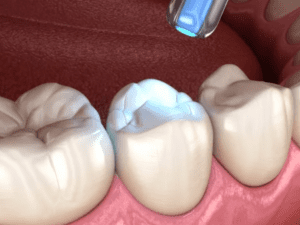A cavity is a pit that develops in the enamel due to tooth decay. If you or your dentist catches it early, the simplest treatment option is a dental filling. A dental filling supports the tooth after the dentist removes the decay.

Tooth Sensitivity
One reason you may need a dental filling is due to tooth sensitivity. When you have a cavity, the inner portion of your tooth gets exposed to temperatures. As the decay burrows farther into your tooth, it irritates and inflames the nerves. As a result, this is what causes the sensitivity to temperatures or sugar. Normally, the nerves are housed deep within the tooth. The tooth’s enamel protects the delicate nerves.
It is possible to have sensitive teeth without a cavity. However, some people naturally have more sensitive teeth than others. Therefore, it is important to talk to your dentist.
Pain
If you have pain or a toothache, you may have a cavity. There are many reasons why your tooth may ache. However, you may want to make an appointment with your dentist if you also have sensitivity. The same reason that a cavity causes sensitivity is the exact reason why it causes you pain. Not only will cavities cause sensitivity, but you can also feel sharp or throbbing pain even when you aren’t eating or drinking.
Dental Filling Process
Before your dentist ever drills into your mouth, they will take an x-ray of all your teeth. Taking an x-ray is a necessary step. While dentists can typically spot dental issues with ease, they cannot see what is going on inside your teeth. X-rays allow your dental team to discover the full scope of your tooth decay. This gives them the opportunity to make a plan for your dental care.
Next, your dentist applies a numbing gel to your gums before they proceed. This is so that you won’t experience any pain during the procedure, including the anesthetic injections. The anesthetic will completely remove any sensation. Therefore, you won’t feel pain. However, you may feel pressure on your gums as your dentist works. If you do feel pain, you should tell your dentist as soon as possible.
Once you are completely numb, the dentist will use a high-powered drill or another tool to remove the decayed portion of your tooth. After removing the decay, they will determine the need for a dental filling or crown. It depends on the severity of your cavity. Before filling the pit, they will thoroughly clean the tooth. This ensures that there are no bacteria left to create an infection.
Finally, they will fill the cavity with a dental filling. There are several types of dental fillings, including composite resin and metal. Composite fillings are incredibly popular because they are tooth-colored, making them nearly invisible. If you receive a composite filling, your dentist must cure the resin to harden it. Then, they will shape and polish the filling to ensure a proper fit.
